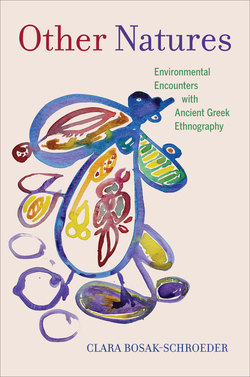Читать книгу Other Natures - Clara Bosak-Schroeder - Страница 8
На сайте Литреса книга снята с продажи.
ОглавлениеAcknowledgments
My mother, Bethany Schroeder, read every paper I wrote until I reached college, when she told me I was on my own. Those years of free instruction made me the writer I am today. Although she died before I began work on my dissertation, let alone this book, I thought of her constantly during the writing of it. After completing an MFA at Cornell, she was offered the opportunity to do a PhD in creative writing but returned to nursing instead. Her rejection of academia and scholarly writing is something I think of every day in my own academic life. Although this book makes certain assumptions about its audience, it was written in the hope that a more expansive readership might find it accessible, even inviting. If I have succeeded at all in this goal, it is thanks to her.
My great thanks also goes to the people who read this manuscript in its entirety, some of them multiple times: my father, Jon Bosak; my husband, Joe Dunker; my best friend, Harriet Fertik; my research assistant, Adam Kozak; my copy editor, Sharon Langworthy; the anonymous readers who volunteered their labor to UC Press; the team I assembled for a manuscript workshop in the fall of 2017—Dan Leon, Bob Morrissey, Mark Payne, Carol Symes, and Nora Stoppino; and my dissertation committee—Francesca Schironi, Paolo Asso, Ian Moyer, and Ruth Scodel—who read it in an earlier form. Francesca Schironi’s skepticism of ancient ecological criticism kept me grounded in philology, while Paolo Asso’s questions about “nature” launched me into areas of critical theory that have proved fruitful ever since. Because of Ian Moyer, I began to look for non-Greek influences in Greek texts. When Ruth Scodel said my project was interesting, I began to think it might have a future.
A number of other people read chapters along the way, including Emily Baragwanath, Barbara Becker, Claudia Brosseder, Page duBois, Sam Frost, Lisa Hau, Rana Hogarth, Jamie Jones, Ellen Lee, Sarah Linwick, Debra Moskovitz, Walter Penrose, Erin Peters, Amy Pistone, Stephanie Rutherford, Eric Schmidt, Ariana Traill, and Rod Wilson; Antoinette Burton and the 2017–2018 workshop at the Illinois Program for Research in the Humanities; Rafe Neis and other attendees of the 2017 Non/human Materials Before Modernity conference; and my grad school community at the University of Michigan.
Rebecca Futo Kennedy and Molly Jones-Lewis nurtured an earlier version of chapter 4, “Dietary Entanglements,” first as a paper delivered at the 2013 meeting of the Classical Association of the Middle West and South and then as a contribution to their edited volume, The Routledge Handbook of Identity and the Environment in the Classical and Medieval Worlds (2016). This early opportunity to publish helped me both to develop a chapter of what would become this book and to get the academic job that has supported its completion.
A number of scholars helped me understand ancient Egypt, India, the Middle East, and Scythia, including Balbina Bäbler, Ted Kelting, Anatoly Khazanov, Francesca Rochberg, Tom Trautmann, and Terry Wilfong. Many of them responded to a plea for help without ever having met me. An even greater number of strangers responded to my questions on Twitter about diction, bibliography, and accessibility.
The introduction and final chapter, which deal with museums of natural history, would not have been possible without the generosity of museum staff at the California Academy of Sciences, the Carnegie Museum of Natural History, the Chicago Field Museum, and the Whale Museum: Patience Baach, Barbara Becker, Joseph Dresch, Erin Peters, Becca Shreckengast, and Seth Cotterell, as well as other museum professionals, including Courtney Cottrell, Amy Powell, and Stephanie Rutherford. I am particularly grateful to Debra Moskovitz, who helped me understand not only the history of exhibits at the Field Museum but also the constraints under which curators operate.
The scope, structure, and intellectual stakes of the project were worked out in two workshops through the Office for the Vice Chancellor for Research at UIUC, the First Book Writing Group and an NEH application writing group. My thanks both to the university for supporting faculty writing and to the comments of Amanda Ciafone, Maria Gillombardo, Verena Höfig, Craig Koslofsky, Carol Symes, and Shelley Weinberg.
Without having time off from teaching and funding to travel to museums, this book would have been much more difficult to write. My thanks to the Illinois Program for Research in the Humanities, the Unit for Criticism and Interpretive Theory, and the LEAP program at UIUC, as well as to Antony Augoustakis and Ariana Traill, my heads of department, for authorizing these leaves, and to Serena Witzke and Krishni Burns, the contingent faculty who taught so I could write.
I started thinking about ethnography with Trevor Murphy as an undergraduate at the University of California, Berkeley, in an independent study on Pliny the Elder. Cal is also where I studied Greek with Leslie Kurke and Ron Stroud and critical theory with Glynda Hull. It was Karla Herndon and Sarah Morrison at Berkeley High School whose Latin instruction set me on this path.
Eric Schmidt is the best editor I could have asked for. His compassion, transparency, and encouragement meant so much at every stage. Rafe Neis’s painting Garrulous Quails, photographed by the ever-patient Chris Brown, renewed my faith in the project at a crucial moment. I am honored to share its company.
Finally, I am grateful to my fellow scholars and teachers with chronic illness, mental illness, and other disabilities. Some of you spoke openly about your experiences, while others whispered them in closed offices and private chat groups. But you all sustained me.
